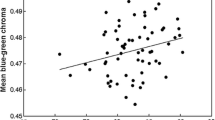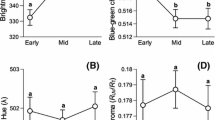Abstract
Eggshell blue-green colouration (BGC) is caused by the pigment biliverdin which has antioxidant capacities. Eggshell BGC has therefore been interpreted as being costly for the female and therefore a signal of female quality (‘sexual signalling hypothesis’). Southern rockhopper penguins Eudyptes chrysocome exhibit both a reversed hatching asynchrony and a brood reduction strategy. First-laid (A-)eggs are smaller and hatch on average 1 day after second-laid (B-)eggs, with B-eggs usually producing the only surviving chick. According to the sexual signalling hypothesis, we predicted a positive relationship between BGC and both female body mass and egg mass, and consequently within clutches a stronger BGC in B-eggs than A-eggs. Furthermore, we expected a negative relationship between BGC and clutch initiation date. Contrasting these expectations, we found no effect of female body mass or egg mass on BGC, and BGC in A-eggs increased with clutch initiation date, while there was no effect in B-eggs. Within clutches, A-eggshells were more intensely blue-green coloured than B-eggshells. Concluding, our results appear to contradict the sexual signalling hypothesis. We, however, did not measure pigment concentrations and solely relied on BGC from eggshell photospectrometry, assuming that biliverdin concentrations were positively correlated with BGC. We therefore caution that before precluding the sexual signalling hypothesis, future studies that include measurements of eggshell pigment concentrations in addition to BGC are necessary. Altogether, a better understanding of the biological meaning of biliverdin, its biochemical synthesis and antioxidative function in the avian body is urgently needed.




Similar content being viewed by others
References
Bates D, Maechler M, Bolker B (2011) lme4: linear mixed-effects models using S4 classes. R package version 0999375-42. http://cran.r-project.org/package=lme4
Cassey P, Ewen JG, Blackburn TM, Hauber ME, Vorobyev M, Marshall NJ (2008) Eggshell colour does not predict measures of maternal investment in eggs of Turdus thrushes. Naturwissenschaften 95:713–721. doi:10.1007/s00114-008-0376-x
Cassey P, Miksík I, Portugal SJ, Maurer G, Ewen JG, Zarate E, Sewell MA, Karadas F, Grim T, Hauber ME (2012a) Avian eggshell pigments are not consistently correlated with colour measurements or egg constituents in two Turdus thrushes. J Avian Biol 43:503–512. doi:10.1111/j.1600-048X.2012.05576.x
Cassey P, Thomas GH, Portugal SJ, Maurer G, Hauber ME, Grim T, Lovell PG, Mikík I (2012b) Why are birds’ eggs colourful? Eggshell pigments co-vary with life-history and nesting ecology among British breeding non-passerine birds. Biol J Linn Soc 106:657–672. doi:10.1111/j.1095-8312.2012.01877.x
Cherry MI, Gosler AG (2010) Avian eggshell coloration: new perspectives on adaptive explanations. Biol J Linn Soc 100:753–762. doi:10.1111/j.1095-8312.2010.01457.x
Christians JK (2002) Avian egg size: variation within species and inflexibility within individuals. Biol Rev 77:1–26. doi:10.1017/S1464793101005784
Crawford RJM, Makhado AB, Upfold L, Dyer BM (2008) Mass on arrival of rockhopper penguins at Marion Island correlated with breeding success. Afr J Mar Sci 30:185–188. doi:10.2989/AJMS.2008.30.1.19.469
Dehnhard N, Poisbleau M, Demongin L, Ludynia K, Quillfeldt P (2014) High juvenile annual survival probabilities in southern rockhopper penguins Eudyptes chrysocome are independent of individual fledging traits. Ibis 156:548–560. doi:10.1111/ibi.12167
Demongin L, Poisbleau M, Raya Rey A, Schiavini A, Quillfeldt P, Eens M, Strange IJ (2010) Geographical variation in egg size dimorphism in rockhopper penguins. Polar Biol 33:469–476. doi:10.1007/s00300-009-0722-2
Falchuk KH, Contin JM, Dziedzic TS, Feng ZL, French TC, Heffron GJ, Montorzi M (2002) A role for biliverdin IX alpha in dorsal axis development of Xenopus laevis embryos. Proc Nat Acad Sci 99:251–256. doi:10.1073/pnas.012616099
Fox J, Weisberg S (2010) An R companion to applied regression, 2nd edn. Sage, Thousand Oaks CA. http://socserv.socsci.mcmaster.ca/jfox/Books/Companion
Gorchein A, Lim CK, Cassey P (2009) Extraction and analysis of colourful eggshell pigments using HPLC and HPLC/electrospray ionization tandem mass spectrometry. Biomed Chromatog 23:602–606. doi:10.1002/bmc.1158
Gwynn AM (1953) The egg-laying and incubation periods of rockhopper, macaroni and gentoo penguins. ANARE Rep Ser B 1:1–29
Hanley D, Doucet SM (2009) Egg coloration in ring-billed gulls (Larus delawarensis): a test of the sexual signaling hypothesis. Behav Ecol Sociobiol 63:719–729. doi:10.1007/s00265-008-0705-2
Hanley D, Heiber G, Dearborn DC (2008) Testing an assumption of the sexual-signaling hypothesis: does blue-green egg color reflect maternal antioxidant capacity? Condor 110:767–771. doi:10.1525/cond.2008.8634
Hargitai R, Herenyi M, Torok J (2008) Eggshell coloration in relation to male ornamentation, female condition and egg quality in the collared flycatcher Ficedula albicollis. J Avian Biol 39:413–422. doi:10.1111/j.0908-8857.2008.04337.x
Honza M, Pozgayova M, Prochazka P, Cherry MI (2011) Blue-green eggshell coloration is not a sexually selected signal of female quality in an open-nesting polygynous passerine. Naturwissenschaften 98:493–499. doi:10.1007/s00114-011-0790-3
Johnsen A, Vesterkjaer K, Slagsvold T (2011) Do male pied flycatchers (Ficedula hypoleuca) adjust their feeding effort according to egg colour? Ethology 117:309–317. doi:10.1111/j.1439-0310.2011.01876.x
Kaur H, Hughes MN, Green CJ, Naughton P, Foresti R, Motterlini R (2003) Interaction of bilirubin and biliverdin with reactive nitrogen species. FEBS Lett 543:113–119. doi:10.1016/S0014-5793(03)00420-4
Kennedy GY, Vevers HG (1976) A survey of avian eggshell pigments. Comp Biochem Physiol B 55:117–123
Kilner RM (2006) The evolution of egg colour and patterning in birds. Biol Rev 81:383–406. doi:10.1017/S1464793106007044
Krist M (2011) Egg size and offspring quality: a meta-analysis in birds. Biol Rev 86:692–716. doi:10.1111/j.1469-185X.2010.00166.x
Krist M, Grim T (2007) Are blue eggs a sexually selected signal of female collared flycatchers? A cross-fostering experiment. Behav Ecol Sociobiol 61:863–876. doi:10.1007/s00265-006-0315-9
López-Rull I, Miksik I, Gil D (2008) Egg pigmentation reflects female and egg quality in the spotless starling Sturnus unicolor. Behav Ecol Sociobiol 62:1877–1884. doi:10.1007/s00265-008-0617-1
Morales J, Sanz JJ, Moreno J (2006) Egg colour reflects the amount of yolk maternal antibodies and fledging success in a songbird. Biol Lett 2:334–336. doi:10.1098/rsbl.2006.0471
Morales J, Velando A, Moreno J (2008) Pigment allocation to eggs decreases plasma antioxidants in a songbird. Behav Ecol Sociobiol 63:227–233. doi:10.1007/s00265-008-0653-x
Morales J, Velando A, Torres R (2011) Biliverdin-based egg coloration is enhanced by carotenoid supplementation. Behav Ecol Sociobiol 65:197–203. doi:10.1007/s00265-010-1025-x
Morales J, Ruuskanen S, Laaksonen T, Eeva T, Mateo R, Belskii E, Ivankina EV, Järvinen A, Kerimov A, Korpimäki E, Krams I, Mänd R, Morosinotto C, Orell M, Qvarnström A, Siitari H, Slater FM, Tilgar V, Visser ME, Winkel W, Zang H, Moreno J (2013) Variation in eggshell traits between geographically distant populations of pied flycatchers Ficedula hypoleuca. J Avian Biol 44:111–120. doi:10.1111/j.1600-048X.2012.05782.x
Moreno J, Osorno JL (2003) Avian egg colour and sexual selection: does eggshell pigmentation reflect female condition and genetic quality? Ecol Lett 6:803–806. doi:10.1046/j.1461-0248.2003.00505.x
Moreno J, Barbosa A, Potti J, Merino S (1997) The effects of hatching date and parental quality on chick growth and creching age in the chinstrap penguin (Pygoscelis antarctica): a field experiment. Auk 114:47–54
Moreno J, de Leon A, Fargallo JA, Moreno E (1998) Breeding time, health and immune response in the chinstrap penguin Pygoscelis antarctica. Oecologia 115:312–319. doi:10.1007/s004420050522
Moreno J, Morales J, Lobato E, Merino S, Tomás G, Martínez-de la Puente J (2005) Evidence for the signaling function of egg color in the pied flycatcher Ficedula hypoleuca. Behav Ecol 16:931–937. doi:10.1093/beheco/ari072
Moreno J, Lobato E, Morales J, Merino S, Tomas G, Martinez-de la Puente J, Sanz JJ, Mateo R, Soler JJ (2006) Experimental evidence that egg color indicates female condition at laying in a songbird. Behav Ecol 17:651–655. doi:10.1093/beheco/ark014
Nakagawa S, Schielzeth H (2010) Repeatability for Gaussian and non-Gaussian data: a practical guide for biologists. Biol Rev 85:935–956. doi:10.1111/j.1469-185X.2010.00141.x
Nakagawa S, Schielzeth H (2013) A general and simple method for obtaining R2 from generalized linear mixed-effects models. Method Ecol Evol 4:133–142. doi:10.1111/j.2041-210x.2012.00261.x
Navarro C, Pérez-Contreras T, Avilés JM, Mcgraw KJ, Soler JJ (2011) Blue-green eggshell coloration reflects yolk antioxidant content in spotless starlings Sturnus unicolor. J Avian Biol 42:538–543. doi:10.1111/j.1600-048X.2011.05293.x
Nisbet ICT, Dann P (2009) Reproductive performance of little penguins Eudyptula minor in relation to year, age, pair-bond duration, breeding date and individual quality. J Avian Biol 40:296–308. doi:10.1111/j.1600-048X.2008.04563.x
Perrins CM (1973) Timing of birds’ breeding seasons. Ibis 112:242–255. doi:10.1111/j.1474-919X.1970.tb00096.x
Poisbleau M, Demongin L, Strange IJ, Otley H, Quillfeldt P (2008) Aspects of the breeding biology of the southern rockhopper penguin Eudyptes c. chrysocome and new consideration on the intrinsic capacity of the A-egg. Polar Biol 31:925–932. doi:10.1007/s00300-008-0431-2
Poisbleau M, Carslake D, Demongin L, Eens M, Chastel O, Quillfeldt P (2011a) Yolk androgen deposition without an energetic cost for female rockhopper penguins: a compensatory strategy to accelerate brood reduction? Biol Lett 7:605–607. doi:10.1098/rsbl.2010.1134
Poisbleau M, Demongin L, Chastel O, Eens M, Quillfeldt P (2011b) Yolk androgen deposition in rockhopper penguins, a species with reversed hatching asynchrony. Gen Comp Endocrinol 170:622–628. doi:10.1016/j.ygcen.2010.11.027
Polito MJ, Miller AK, Trivelpiece SG, Trivelpiece WZ (2010) Maturation increases early reproductive investment in Adélie penguins Pygoscelis adeliae. Ibis 152:38–47. doi:10.1111/j.1474-919X.2009.00971.x
R Development Core Team (2014) R: a language and environment for statistical computing. R Foundation for Statistical Computing, Vienna. http://www.R-project.org/
Reid WV, Boersma PD (1990) Parental quality and selection on egg size in the Magellanic penguin. Evolution 44:1780–1786
Riehl C (2011) Paternal investment and the “sexually selected hypothesis” for the evolution of eggshell coloration: revisiting the assumptions. Auk 128:175–179. doi:10.1525/auk.2011.10171
Robinson S, Chiaradia A, Hindell MA (2005) The effect of body condition on the timing and success of breeding in little penguins Eudyptula minor. Ibis 147:483–489. doi:10.1111/j.1474-919x.2005.00431.x
Schielzeth H, Nakagawa S (2013) rptR: repeatability for Gaussian and non-Gaussian data. R package version 06405/r52. http://r-forge.r-project.org/projects/rptr
Siefferman L, Navara KJ, Hill GE (2006) Egg coloration is correlated with female condition in eastern bluebirds (Sialia sialis). Behav Ecol Sociobiol 59:651–656. doi:10.1007/s00265-005-0092-x
St. Clair CC, St. Clair RC (1996) Causes and consequences of egg loss in rockhopper penguins, Eudyptes chrysocome. Oikos 77:459–466
Stocker R, McDonagh AF, Glazer AN, Ames BN (1990) Antioxidant activities of bile pigments: biliverdin and bilirubin. Meth Enzymol 186:301–309. doi:10.1016/0076-6879(90)86123-D
Strange IJ (1982) Breeding ecology of the rockhopper penguin (Eudyptes crestatus) in the Falkland Islands. Gerfaut 72:137–188
Underwood TJ, Sealy SG (2002) Adaptive significance of egg colouration. In: Deeming DC (ed) Avian incubation: behaviour, environment and evolution. Oxford University Press, Oxford, pp 280–289
Vleck CM, Vleck D (2002) Physiological condition and reproductive consequences in Adélie penguins. Integ Comp Biol 42:76–83. doi:10.1093/icb/42.1.76
Warham J (1975) The crested penguins. In: Stonehouse B (ed) The biology of penguins. The Macmillan Press, London, pp 189–269
Williams M, Krootjes BBH, van Steveninck J, Der Zee J (1994) The pro- and antioxidant properties of protoporphyrin IX. Biochim Bipohys Acta 1211:310–316. doi:10.1016/0005-2760(94)90155-4
Zuur AF, Ieno EN, Elphick CS (2010) A protocol for data exploration to avoid common statistical problems. Method Ecol Evol 1:3–14. doi:10.1111/j.2041-210X.2009.00001.x
Acknowledgments
We are grateful to the New Island Conservation Trust and Petra Quillfeldt for the possibility to carry out this study on the island and for logistic support. We wish to thank Ian, Maria and Georgina Strange as well as George Guille for their support during the field season. We would like to thank the editor of Polar Biology, Prof. Dr. Dieter Piepenburg, and several anonymous reviewers for comments on this manuscript. The study was performed according to Belgian and Flemish law and was approved by the ethical committee on animal experimentation (ECD, ID Number: 2011/44). All work was conducted under research licences granted by the Environmental Planning Department of the Falkland Islands Government (research Licence Numbers: R06/2009). Our study was funded by Fonds Wetenschappelijk Onderzoek—Vlaanderen (FWO; Grant Numbers 1.2.619.10.N.00 and 1.5.020.11.N.00 to MP and 1265414 N to ND) and Antwerp University.
Author information
Authors and Affiliations
Corresponding author
Rights and permissions
About this article
Cite this article
Dehnhard, N., Pinxten, R., Demongin, L. et al. Relationships between female quality, egg mass and eggshell blue-green colouration in southern rockhopper penguins: a test of the sexual signalling hypothesis. Polar Biol 38, 1805–1811 (2015). https://doi.org/10.1007/s00300-015-1742-8
Received:
Revised:
Accepted:
Published:
Issue Date:
DOI: https://doi.org/10.1007/s00300-015-1742-8




